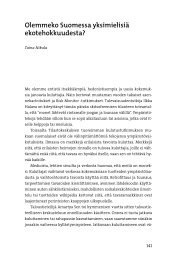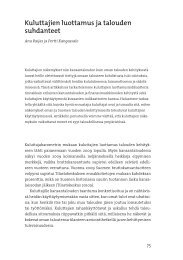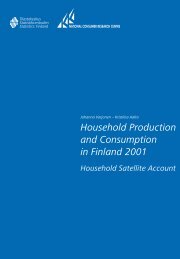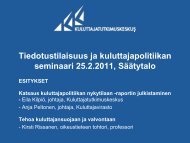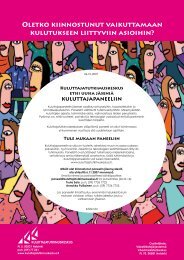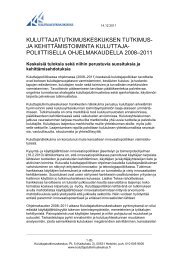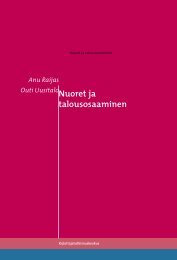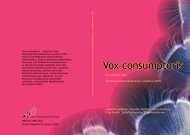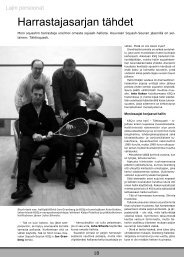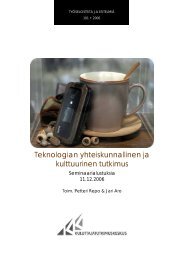Household Production and Consumption in Finland 2001
Household Production and Consumption in Finland 2001
Household Production and Consumption in Finland 2001
Create successful ePaper yourself
Turn your PDF publications into a flip-book with our unique Google optimized e-Paper software.
8 Discussion ofthe results <strong>and</strong> needs<br />
for further research<br />
8.1 Interplay oftime <strong>and</strong> money <strong>in</strong> household<br />
services<br />
The results produced by the <strong>Household</strong> Satellite Account are of a new k<strong>in</strong>d, <strong>in</strong><br />
two respects. First, the account produces quantitative <strong>in</strong>formation on how<br />
households comb<strong>in</strong>e time <strong>and</strong> money <strong>in</strong> their productive activities. Secondly,<br />
it produces monetary estimates for the value of household production <strong>in</strong><br />
different types of households <strong>and</strong> <strong>in</strong> different pr<strong>in</strong>cipal functions.<br />
When households make decisions on how to obta<strong>in</strong> the services they need<br />
or that make their everyday life easier, time <strong>and</strong> money are to some extent<br />
regarded as substitutes for one another. In microeconomics, researchers have<br />
sought to expla<strong>in</strong> the use of time <strong>and</strong> money by means of econometric models,<br />
<strong>in</strong>spired by Becker’s theory of time use allocation. The alternative use of time<br />
<strong>and</strong> money is approached not only as a resource issue, but also as a value issue<br />
that reflects households’ priorities <strong>and</strong> decision-mak<strong>in</strong>g. The models exam<strong>in</strong>e<br />
decision-mak<strong>in</strong>g situations <strong>in</strong> <strong>in</strong>dividual activities.<br />
The statistics compiled <strong>in</strong> the present Satellite Account describe the<br />
monetary value of the goods <strong>and</strong> services produced by all the households <strong>in</strong> the<br />
country for their own use. Its aim is not to expla<strong>in</strong> why money <strong>and</strong> labour are<br />
comb<strong>in</strong>ed <strong>in</strong> certa<strong>in</strong> ways, but to describe how they were comb<strong>in</strong>ed <strong>in</strong> <strong>2001</strong>.<br />
In order to give more depth to the picture, production is divided <strong>in</strong>to pr<strong>in</strong>cipal<br />
functions. Accounts are produced separately for ten different types of<br />
households, which represent different life-stages <strong>and</strong> family structures. The<br />
value of production is calculated on the basis of national account<strong>in</strong>g rules<br />
apply<strong>in</strong>g the <strong>in</strong>put method: the accounts show the share of labour, the<br />
consumption of fixed capital, raw materials <strong>and</strong> other <strong>in</strong>termediate<br />
consumption <strong>and</strong> gross fixed capital formation separately. Where possible the<br />
value of goods <strong>and</strong> services substitut<strong>in</strong>g household production, i.e. purchased<br />
f<strong>in</strong>al consumption products, is <strong>in</strong>dicated separately alongside the value of own<br />
production. The figures provide a clear picture of how different types of<br />
households spend their time (i.e. labour) <strong>and</strong> money when purchas<strong>in</strong>g or<br />
produc<strong>in</strong>g goods <strong>and</strong> services.<br />
68 Statistics F<strong>in</strong>l<strong>and</strong> National Consumer Research Centre




